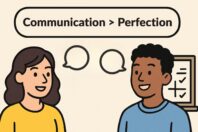How To Speak Spanish Like A Native: Listen And Mimic

Get our free email course, Shortcut to Conversational.
Have conversations faster, understand people when they speak fast, and other tested tips to learn faster.
More infoIn a separate post, I wrote about grammar, in the sense of things that actually have rules and can be taught.
But when it comes to speaking like a native, there are a lot of things that you can’t really be taught. You have to learn them like a baby, by listening to other people and then mimicking them.
This is how you learn all of the things that don’t have direct translations, and the things that have so many different shades of meaning that it would be impossible to explain in a concrete manner.
Sidenote: I wouldn’t worry too much about this strategy until you have at least a hacked-conversational level, as you need some framework of understanding for these fuzzy concepts to rest on.
How Mimicry Works
Let’s take the word “ya”.
The way it’s typically taught, “ya” is just listed as meaning “already”, and that’s the end of the story.
But ya is SO much more. In fact, it’s one of my favorite words in Spanish and I wish we had something like it in English.
In English, “already” generally carries the implication that it happened a while ago. If you just did something, you’re not going to say that you already did it.
But “ya” doesn’t have that.
Ya could be any time in the past, even if that’s a fifteenth of a second ago.
You see, a teacher can explain that shade of meaning for you, just like I just did.
But “ya” has so many other uses that are impossible to explain. You only begin to understand all of the different shades of meaning the word carries by hearing people use it.
For instance, you’ll pick up that if you’re sitting in the living room and are waiting on someone to get their shoes on so you can all go out for lunch, and they walk back into the room with their shoes on, you could simply ask, “ya?”. In this case, “ya” is more like “ready?” than “already”.
You can also say “y ya”, which is very common and basically means “and that’s it.”
Noticing in what contexts people do and don’t use words and then mimicking them is central to how you learned as a little kid.
It’s how you if you hear someone speaking English when it’s not their native language and hear them say a word that just seems “off”, that you know that the word is “off”.
There aren’t hard cut rules, just an understanding of how the word is used based on hearing it hundreds or thousands of times in different contexts and your brain crunching some meaning out of those experiences to create some fuzzy, subconscious guidelines in your head.

Download the expanded guide to read later
This page gives you a great overview of the most important concepts and strategies, but for the full, expanded guide, click the button below:
Download Guide Now!Why Is The Fox Quick?
Here’s a mind-trip example for you to help you understand where this fuzzy-understanding comes in: why is a fox quick, but you say that a dog is fast? If you are native, would you ever say that a fox is fast? No… for some reason it just doesn’t fit, a fox is quick, not fast.
And there are no rules of why this is true, which means you can only learn by hearing people always use quick with fox instead of fast.
Now, this is an extreme example to illustrate the point, and being so native that you care about quick vs. fast shouldn’t and won’t be your worry until you’re already fluent, but the same form of learning is used when learning the shades of a much more basic word like “ya”.
That’s how you learn “fuzzy” concepts.
So the way to learn the fuzzy concepts – things that don’t really “make sense” when translated into English – is to listen and mimic.
I learned this method from Idahosa Ness who was an expert I consulted with on accent training for my documentary, which has already been viewed by over one million language learners.
All you do is listen to people speak. See how they use words. And then copy them – even when it doesn’t make sense. Especially when it doesn’t make sense.
Just try to test using the words out like they do. Repeat things. It’s a very fuzzy process that is by necessity a bit self-taught, but is the key to speaking like a native.
This post was an excerpt from a 119-page book I wrote about the tactics and strategies I used to learn Spanish fast in my “Spanish in a Month” documentary,
If you want to replicate the success I had, then you can download the entire book, for free, right now.

Download the expanded guide to read later
This page gives you a great overview of the most important concepts and strategies, but for the full, expanded guide, click the button below:
Download Guide Now!



